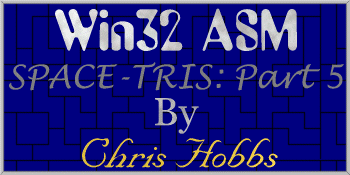11/10 - 11/12 @ Montréal, Canada
12/5 - 12/7 @ Shanghai, China
12/24 - 12/27
2/28 - 3/4 @ San Francisco, CA
More events...
2406 articles in the reference section.
Help us fight cancer!
Join SETI Team GDNet!

|
The Sound ModuleThe sound module for this game is pretty simple. It merely presents an interface to Load WAV files, play the sounds, delete them, and edit properties about them. However, there are a few tricky things to watch out for in the module. The first thing I want to illustrate is how to create an array of structures. Take a look at the following modified code snippet. You will notice that anytime we declare a structure we need to use angle brackets, or curly braces (not shown), for them. The numbers inside consist of the members of your structure and nothing more. Whatever you place there is what things get initialized to. Also, pay attention to how the structure is defined. It consists of normal variable declarations in between a couple of keywords and a tag to give it a name. Of special note, is that you must use another set of braces, or brackets, if you wish to have nested structures. The way we get an array with a structure is the same as any other variable. We use the number we want followed by the DUP ... then, in parenthesis, what you want the values initialized as. We are going to skip over the DS_Init() and DS_Shutdown() procedures, since they do the same exact things as the other DX counterparts. Instead let's take a peek at Play_Sound(). This is the routine that we use to start a sound playing. You can pass it flags to alter how it sounds. So far as I know there are only 2 options for the flags. If you pass in NULL then it plays the sound once. If you pass in DSBPLAY_LOOPING it will play the sound repeatedly. The routine begins by checking that the sound has a valid buffer associated with it. If so, it sets the position of that sound to the beginning and then makes a call to begin playing it with whatever flags were passed in. The only thing worth illustrating in this routine is how the structure element is referenced. To begin with we obtain the size of the structure and multiply that by the id of the sound to give us our position in the array. Then, in order to reference a member you treat it just like you would in C/C++ ... StructName[position].member ... the important thing is not to forget to multiply the element by the size of the structure. The next 3 routines allow you to set the volume, frequency, and pan of a sound. There is nothing to these routines ... they are just wrappers for the Direct Sound function calls. However, if you want to use anything but Set_Sound_Volume() you need to tell Direct Sound that you want those enabled when you load the sound. This is done by passing in DSBCAPS_CTRL_PAN or DSBCAPS_CTRLFREQ respectively. If you do not specify these flags when you load your sound you will not be able to manipulate those items. The next two functions are for stopping sounds from playing. One will stop the specific sound you pass in and the other will stop all of the sounds from playing. Here is the code if you want to take a peek. Once again these are merely wrapper functions to shield you from the DX headache. Delete_Sound() and Delete_All_Sounds() are remarkably similar to the sound stopping functions. The only difference is you make a different function call to DX. Delete_Sound() will call Stop_Sound() first, to make sure the sound isn't trying to be played while you are trying to delete it. The interesting thing about these two functions is that you do not personally have to release any of your sounds if you don't want to. During shutdown of Direct Sound all the sounds that you loaded will be deleted. However, if you have reached your maximum in sounds, and want to free one up, you will need to manually delete it. The next function Status_Sound() is yet another wrapper routine. It is used when you need to find out if a sound is still playing, or if it has stopped already. You will see this function put to use later on. There, 90% of that stupid module is out of the way. Now, we need to move on to the final 10% of that code ... the Load_WAV() procedure.
|
|
|
|
|